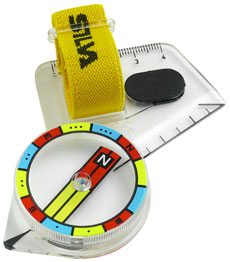Types of compasses

- Baseplate compass (Orienteering compass)
This type of compass was developed by the Kjellstrom brothers and another keen orienteer, Gunnar Tillander in Sweden in the early 1930's. They combined a liquid-filled compass in a housing which could rotate over a protractor base. This saved a lot of time transferring bearings from compass to map. It proved to be a new and greatly successful system of direction- finding for outdoor activities.
These compasses are made of clear plastic or perspex. They have a rectangular base with a 360° dial mounted upon it. Inside the raised dial is a magnetic needle suspended in clear fluid. The dial October may be turned to read a correct bearing along the direction of travel arrow which is clearly marked on the base plate.
- Needle compass (Pocket compass)
This type of compass has a magnetised needle suspended over a fixed card which has been marked off in a clockwise direction in 360 equal units(degrees). The cardinal compass points, north (0°), east (90°), south (180°) and west (270°) are always clearly marked. Intercardinal points (NE, SE, SW and NW) are usually shown plus divisions between these and the cardinal points, thus giving a total of sixteen compass directions. The needle moves freely to align itself north-south as the compass is turned.

- Card compass (Marine compass)
In this compass the needle is fixed while the compass card is mounted in fluid (is damped) and moves. Because the moving card absorbs much of the motion of a boat it is easier to read than a needle compass. The top of the compass is typically a hemispherical shape and may provide magnification of the readings on the card. The card is normally marked to show all readings from 0° through to 360°. These compasses are usually mounted on the boat near to the steering apparatus in which case they are called the steering compass. Care must be taken not to allow nearby magnetic fields (e.g. metal apparatus) to interfere with the working of the compass. Hand held models can be used to sight bearings of objects in the distance when fixing position.

- Thumb compass
This is a recently developed (1980's) modification of the baseplate compass where the baseplate is re-modelled to fit around the thumb so that the map and compass can be held together in one hand, leaving the other hand free. It is used chiefly for orienteering and rogaining.
- Gyrocompass
This is an electric compass and as such is not affected by magnetic fields. Readings are true bearings and there is no need for adjustment for the Earth's magnetic field. These compasses are sophisticated, stable and very accurate. Large ocean-going vessels use a gyrocompass as their steering compass. Due to their size, weight and cost they are not usually found in use on smaller craft.

- Prismatic compass
This compass has a glass prism sighting arrangement and a lid with a hairline for lining up the object to be sighted. The compass card rotates in the base and when it comes to rest the required bearing is read off, through the prisms. These are quite sophisticated hand compasses.
|



